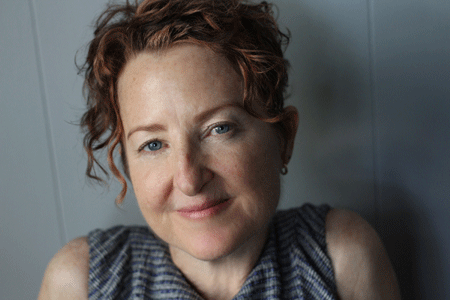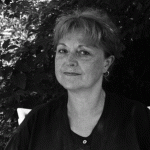Meet a NYFA Artist: Myra Melford
NYFA speaks with Myra Melford (NYFA Fellow in Music Composition, 1992, ‘98, ’02) about her composition process, her upcoming solo piano album, Life Carries Me This Way, and her new mixed media piece, Language of Dreams, which debuts at the Yerba Buena Center for the Arts this November.
NYFA: When did you start playing piano, and how did your career as a musician begin?
MM: I began playing the piano when I was three years old. We had a piano in the house and my older siblings were taking lessons. I would climb up on the bench and improvise until I started taking lessons in kindergarten. My career began after I’d moved to NYC in the mid-’80s. I spent a lot of time going out to hear music and meeting lots of musicians. Soon, I was performing with people like Marion Brandis (who I met in a workshop with Leroy Jenkins) and Lawrence “Butch” Morris, through whom I met many of the people I still work with today. Things really took off when I participated in the first Knitting Factory Tour of Europe in 1990.
NYFA: Can you describe the inspiration behind your songwriting? What’s your composition process like?
MM: I draw great inspiration from other people’s creative work in many different media and am intrigued by the ensuing cross-disciplinary dialogue. I think of it as a very personal conversation which begins with a spark of recognition when I experience a given work of art. Something in that building, the imagery or rhythm in that poem, that dancer’s gestures or that painting, speaks to me or moves me, and I want to respond through music. The conversation is both internal — between the active/doer and the receptive/perceiver within me, and external — between the artwork that inspires and the musical response. It’s a very rich and engaging process on many levels: emotional, intellectual, physical, spiritual, and one I return to again and again in my work.
I took composition lessons with Henry Threadgill in the late ’80s, and to this day I would still count him as my most important mentor in that area. [Editor’s Note: Threadgill received NYFA Fellowships in Music Composition in 1987 & 1991.]
Henry suggested the idea that a piece of music would grow naturally, organically, from an initial idea, and that I didn’t need to impose content or form that didn’t evolve on its own. He offered many ways of developing that initial idea as well as approaches for how to incorporate the numerous, ensuing permutations in ways that might not readily be apparent. He also encouraged me to use the material from the piece to inform the improvisation in ways other than the more conventional jazz model of chord-scale or motivic development. For instance, he suggested I mine the piece for characteristic phrases, intervals, rhythms, and to get those into my hands/ears, so they become the point of departure, rather than imposing habitual modes of playing. His current ensemble, Zooid, is a brilliant example of his evolving philosophy and a continual inspiration to me.
NYFA: You play in several projects, including a quintet, a trio, and a duo. Are there any difficulties that arise from this constant change and how do you navigate the different dynamics of each group?
MM: I enjoy the variety and challenge of playing in many different situations. Each calls for a unique approach, and allows for various aspects of my playing to come forward. The smaller the configuration, the more room there is for range and density, for instance. With the quintet, I’m 1/3 or ¼ of a rhythm section, in a duo with a horn player, I’m essentially the rhythm section on my own, though all of the players I work with are adept at covering background/foreground, rhythmic and harmonic accompaniment, no matter what instrument they play, and everyone is able to call on a huge vocabulary informed by many different kinds of music. It’s so much fun to be able to move fluidly through all of these roles and areas in any ensemble setting.
NYFA: Your first ever solo piano album, Life Carries Me This Way, is set for release this October from Firehouse 12 Records. Can you talk to us about the story behind this album?
MM: This project began through conversations with the wonderful visual artist, Don Reich, a family friend, after I moved to California around 2004-2005. I’d always been inspired by Don’s colorful and quirky work which covered a huge range of expression from landscape and still life, to surrealism and more abstract modes. I knew I wanted to create music as a response to his work, but the project developed slowly, as I was just getting started as a professor of music at UC Berkeley, and was continuing to perform with and compose for other projects. Don eventually offered me a set of his drawings to work with, and after living with his work on my studio walls for a few years, I finally finished composing the music last summer, and recorded it in early 2013. My process for composing this music was a bit different from how I write for my ensembles. I spent a lot of time going back and forth between my notated ideas and how I like to improvise, and really developed the music through “playing” it. I’m so happy with the way it came together, and love that Firehouse 12 Records was able to include a booklet of Don’s work to accompany the recording.

Photo Credit: Michael Wilson
NYFA: You’re a three time NYFA Fellowship recipient in Music Composition (1992, ’98, ’02). How have your music and/or your process changed from the time of your first fellowship to now?
MM: I’d say my process hasn’t changed all that much. I still go back to the things I learned from Henry Threadgill over and over again, but how I apply them is unique to each situation. What does change over the years is the source of inspiration which really informs the specifics of how each project unfolds. And of course, who I’m writing for — be it solo, a mixed media work or a larger ensemble also calls for adaptations of the process.
NYFA: You have a new mixed media piece, Language of Dreams, to debut at the Yerba Buena Center for the Arts in November. The piece will include a combination of music, choreography, narration and video art. Can you talk a bit more about the new piece and your interest in mixed media?
MM: This piece began as a response to Eduardo Galeano’s Memory of Fire trilogy. As the project developed, I composed the music, recalling but not imitating several genres of American music, and arranged it all for my new quintet, Snowy Egret. After that, I started to imagine adding other media. Galeano’s trilogy is a history of the Americas, told through many short vignettes and many points of view, that add up to a very powerful picture of life pre- and post-European colonization, and include myths of the indigenous peoples along with many stories of the cultures and people who populated the Americas up until 1984. I felt that adding other media would enhance the story-telling aspect of the music I’d written. The video, created by David Szlasa, the movement by Oguri, and selections from the text spoken by Sofia Rei, are layered in different ways to create a kind of dreamscape of suggestion and poetry, prompting reflection on the experience of being American today.
NYFA: What are you currently listening to? Any recommendations?
MM: I highly recommend both of the Zooid recordings on Pi Recordings’ This Brings Us To, volumes 1 and 2. Ben Goldberg’s new recordings, Unfold Ordinary Mind and Subatomic Particle Homesick Blues are current favorites, as is Craig Taborn’s solo Avenging Angel on ECM. And there’s lots of stuff I’m looking forward to hearing: Matt Mitchell’s new solo on Scrapple Records, Mary Halvorson’s new ensemble recording on Firehouse 12, Donny McCaslin’s latest for Greenleaf, and Mark Dresser’s new quintet recording, which just came out on Clean Feed. And many others. I’m sure I’m forgetting something great!
— Interview by James Ciano
For more information on Myra Melford, visit her website. To see an excerpt from her upcoming mixed media piece, Language of Dreams, visit her Vimeo page.




